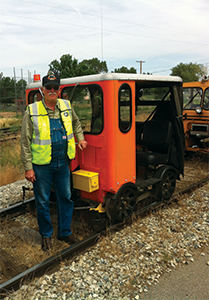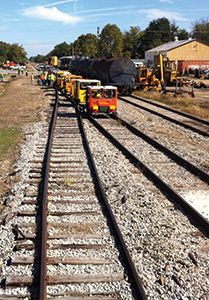On Track
In the years following the Civil War, the railroads brought America together. When the golden spike was driven at Promontory Point, Utah, in 1869, completing the Transcontinental Railroad, it symbolized the ability to transport people and goods from one end of the nation to the other. In essence, the railroads created the modern America.
 But times and technology change. In 2015, railroads are not the social and cultural force they were nearly 150 years ago. Of course, freight companies still move goods by rail, and Amtrak provides passenger service to many areas of the country. However, there are many individuals and organizations with a passion for the old ways and a desire to preserve the heritage of the steel rails.
But times and technology change. In 2015, railroads are not the social and cultural force they were nearly 150 years ago. Of course, freight companies still move goods by rail, and Amtrak provides passenger service to many areas of the country. However, there are many individuals and organizations with a passion for the old ways and a desire to preserve the heritage of the steel rails.
Drake Rice knows well the allure of the rails. “It usually starts with the train set around the Christmas tree and progresses from there,” he recalled. “I grew up in Sand Springs, and my first job after high school was at the power plant, which was next door to the Sand Springs Railway’s engine house. On my lunch break I would go over and talk to the guys at the engine house, and got to ride some of the engines.” With time, Rice’s interest in railroads grew. He was one of the charter members of the Central Oklahoma Railfans Club, which later evolved into the Oklahoma Railway Museum. Today, he serves on the board for the museum.
Still, it wasn’t until a friend in Kansas invited him on an unusual excursion that Rice found a highly specialized and immensely satisfying passion. The friend had purchased a railroad motorcar and took Rice for a ride. “I was hooked,” Rice remembers. “I said, ‘I have to get one of these.’” That passion has led to Rice’s role as the Oklahoma excursion coordinator of the North American Rail Car Operators Association, or NARCOA.
Railway motorcars are small, motorized vehicles that railroads utilized to inspect tracks in decades past. They replaced hand-pumped cars after World War I, and were widely used until the 1980s, when the railroads began to phase them out in favor of Hy-Rail vehicles, which are standard pickup trucks with retractable wheels that can operate on either road or rail. So the railroads sold off all their motorcars, and a hobby was born. Today NARCOA boasts more than 1,700 members nationwide. Rice estimates Oklahoma has about 15 licensed operators who regularly take excursions in the state and beyond.
The motorcars vary in size, some being two-seaters and others which were designed to carry a railroad crew of eight to 10 people, plus tools. They sport four-cylinder engines, two-speed transmissions, a roof and windshield. Top speed is around 35 miles per hour, and the cars are much lighter weight than road vehicles—Rice’s car is 965 pounds. Enthusiasts buy motorcars from dealers, investing anywhere from $3,000 to $5,000 per car. They must pass a rules test to become licensed operators.
 Rice, in his role with the Oklahoma Railway Museum, has developed relationships with most of the smaller railroads operating in Oklahoma. Larger lines, with heavy freight traffic do not participate, but the “short lines” are friendly to the group. Rice works with railroads based in Clinton, Wilburton, Hugo, Stillwater and Wichita Falls, Texas, among others.
Rice, in his role with the Oklahoma Railway Museum, has developed relationships with most of the smaller railroads operating in Oklahoma. Larger lines, with heavy freight traffic do not participate, but the “short lines” are friendly to the group. Rice works with railroads based in Clinton, Wilburton, Hugo, Stillwater and Wichita Falls, Texas, among others.
The excursions, usually scheduled on a weekend, draw enthusiasts not only from Oklahoma, but other states as well. Rice clears the dates with the railroad, coordinates the issuance of an insurance policy, and posts a notice on the NARCOA website, as well as sending out an email to notify members of upcoming excursions.
The operators meet at the designated loading point, and after a safety briefing from the railroad, they load their cars onto the rails. Lining up in a particular order, and with 100 feet between cars for safety, away they go. Once the engines are running and the cars are in gear and moving, the adventure begins. There is no steering wheel on a motorcar, and the operators can simply enjoy the ride. “You get to see a lot of pretty country,” said Rice. “Wildlife, too. Since you’re not along the highway, you see things you wouldn’t see otherwise.”
Each route has predetermined stopping points and a lunch break, which is usually the turnaround point for the round trip. A recent weekend excursion saw the group taking a 126-mile round trip between Clinton and Snyder.
NARCOA members come from all walks of life: engineers, office workers, electricians, machinists. They have a love for the bygone culture of the rails. “Our common bond is that we like railroads, we like motorcars and we like taking trips,” said Rice.
But it’s far more than just taking trips. It’s a different way of looking at life in the 21st century. “It’s about preserving rail history and a mode of transportation that we really don’t have anymore, said Rice. “Today, when people think about travel, they only think of airplanes. But rail travel is very relaxing. Sharing the history of rail travel in Oklahoma is rewarding, and then there’s the camaraderie, a camaraderie of simply going where most people don’t go.”
For more information about NARCOA or the Oklahoma Railway Museum, visit www.narcoa.org or www.oklahomarailwaymuseum.org.




